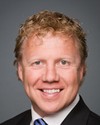Thank you.
Correct. The Studsvik facility in Sweden is the most competent and the only available facility that is currently capable of separating the clean steel from the radioactive steel through that process.
There have been allegations made that there were other ways of doing things. The other ways are not recycling. You have to keep in mind that the current waste management is based on the three Rs: reduce, recycle, and reuse. As the technology becomes much more available and proven, then the three Rs are being applied.
So the Studsvik facility is the only one currently that did successfully service European reactors, where they had higher activity steam generators shipped in from Germany in 2007—on barges, as a matter of fact—through inland waterways to Sweden for recycling.




